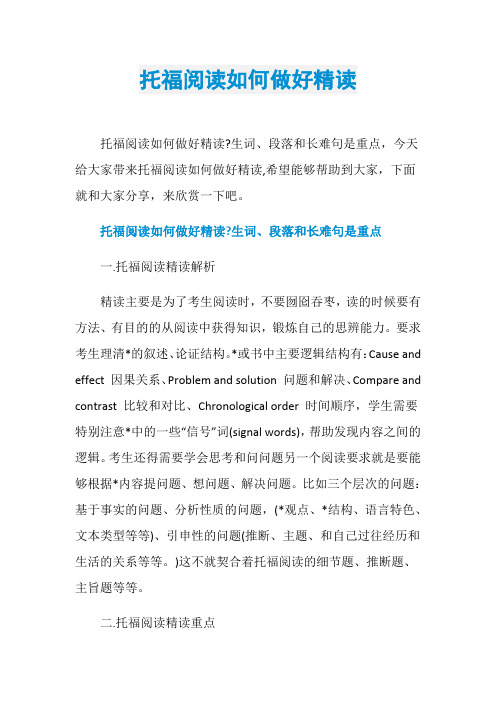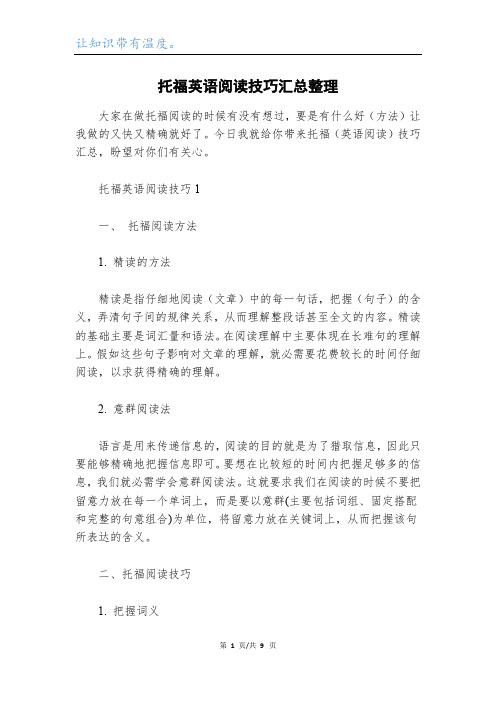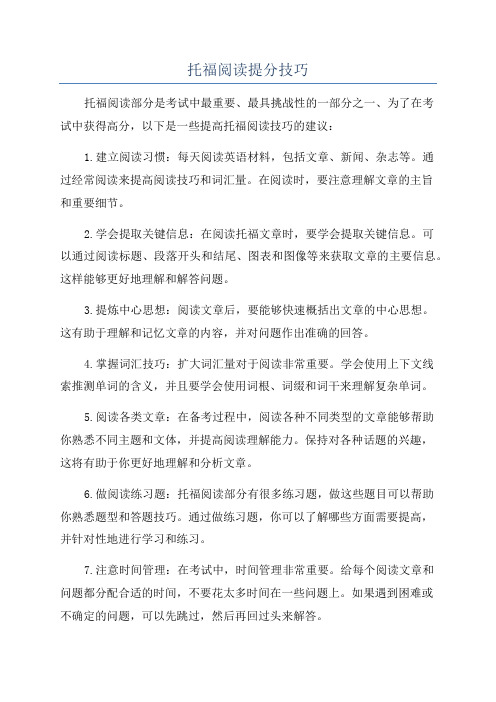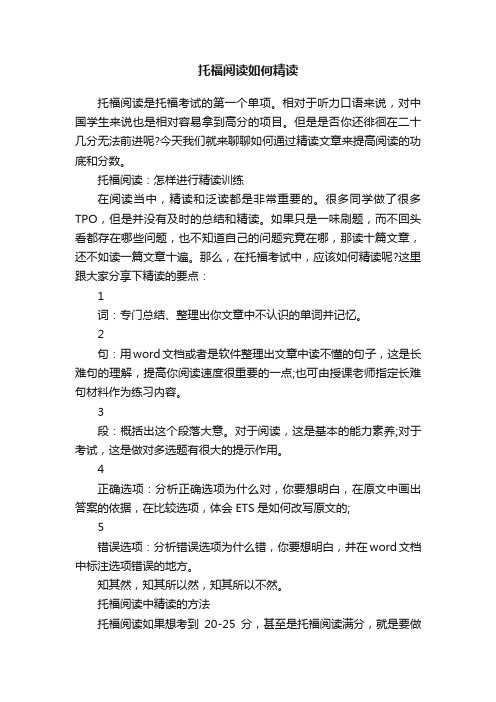如何为托福阅读中的精读和泛读挑选好的素材
托福阅读怎么做精读

托福阅读怎么做精读所谓的托福阅读精读就是快速把握文章中的重要信息和内容,准确提升对字词,句篇的分析能力和解读能力,通过结合相关备考方法提升其准确性和速度,理解材料中的难点和要点并进行归纳推断推断等能力,最后达到人文合一的境界。
STEP1,词汇要求各位同学天天至少浏览200-300个单词,争取一个月内识别6000+个单词,越多越好。
市面上有很多背单词的书籍,大家可以用来研读,肯定会提升背词能力的!STEP2,迅速去掉修饰,直达主干结构。
如动词不按时,现在分词,过去分词,关系词等技巧处理。
STEP3,迅速识别特别句式:如省略句式,倒装句式,强调句式,插入句式,分割句式等。
STEP4,提升对某些重点句子的理解:如带转折的句子,带归纳字眼的句子,带概括动词的句子,设问的句子,段首段末句式等。
STEP5,文章的整体把握阅读,什么地方快速阅读,什么地方慢速阅读,要达到快慢结合,重点特别,最后达到我们阅读杂志或报纸的程度。
2托福阅读答题方法一、做题误区有的考生读文章时喜爱在试题上划线,好像不必须要做记号,阅读便根本没有办法进行,思维就停止。
在新托福网络考试里大家面对电脑时,根本就无法做任何标志记号。
有的考生文章没有办法读完,直接做。
此方法对文章一般只有局部的感觉,整个文章的概念无法获得。
所以,这种不看文章直接做题的方法是其危险的。
二、读文章的方法扫描每一篇文章头一两句,大致的掌握文章大概意思与把文章大致难易程度了解。
通常而言5篇文章里有2篇难度更大,所以首先定位文章难程度,同时目测文章的含金量(即题量分布),有助于科学分配阅读部分的做题时间。
三、做题的方法1. 做题总则:(1)文章题目基本是按照布局向前推动,就算是有一两个题打乱布局,在题干中都是一直会有关键词。
(2)按照题干关键词回文章寻找(3)到难句,进行句子结构分析,迅速把握整个句子,不要盯着单个的词不放(4)问题的四个选项又或是文章里有关部分的解释、或者是歪曲原文、或者与原文毫不相干。
英语专业阅读材料的精读与泛读技巧

英语专业阅读材料的精读与泛读技巧学习英语的过程中,阅读是一个重要的技能。
在英语专业学习中,无论是精读还是泛读,都是必不可少的。
本文将介绍一些英语专业阅读材料的精读与泛读技巧,帮助读者更好地理解和掌握英语专业材料。
一、精读技巧1. 阅读目的明确:在开始精读之前,先确定阅读的目的是什么。
是为了获取信息、学习专业知识还是提高阅读能力?明确目的有助于读者在阅读过程中更加集中注意力。
2. 合理利用工具书:精读的过程中,遇到生词或其他难懂的词汇,可以查阅词典或使用在线翻译工具,确保理解每个词的含义。
同时,专业词汇的理解也可以通过查阅相关的专业词典或参考书籍。
3. 理解文章结构:在阅读过程中,要注意文章的结构和逻辑关系。
通常,文章会按照问题提出、论证和总结的方式进行组织。
了解文章的结构有助于更好地理解文章的意义和观点。
4. 注意关键信息:在精读过程中,要注意抓住文章中的关键信息。
这些信息往往是作者要表达的重点,包括中心思想、主题句和论据等。
通过关注这些关键信息,有助于更好地理解文章的主旨。
5. 反复阅读与总结:精读的目的是深入理解文章的意义。
为了确保完全理解,在阅读一遍之后,可以进行反复阅读,并总结文章的要点、观点和论证。
这有助于加深对文章的理解和记忆。
二、泛读技巧1.阅读速度控制:泛读的目的是获得整体理解,因此读者可以适当加快阅读速度,不必对每个细节过于深入。
掌握适当的阅读速度可以提高泛读的效率。
2.注意文章结构与段落标志:在泛读过程中,注意文章的整体结构,以及各段落之间的逻辑关系。
通常,每个段落都有自己的主题和主旨,注意段落开始的关键词可以帮助理解整体的组织结构。
3.有效运用排除法:泛读过程中,遇到难以理解的句子或词组可以尝试通过排除法进行推测。
通过理解上下文,排除一些明显错误的选项,有助于更好地理解整体内容。
4.关注文章中的关键词和关联词:在泛读过程中,要注意抓住文章中的关键词和关联词。
这些词汇可以帮助读者理解文章的主题、主旨和论证。
如何练习托福阅读精读能力

如何练习托福阅读精读能力在深入精读段落中的每个句子之后,考生必须要对该段落的第一句中的整个段落进行梳理一遍。
今天我主要给大家分享如何学习〔托福〕阅读精读能力,希望对你们有帮助!一、选择精读文章托福阅读考试涵盖了广泛的话题,如生物学、自然学和社会学。
用于托福阅读精读的文章应依据不同的题材在TPO阅读文章中选择,使用常常视察的话题题材,选择2-3篇文章。
这可以帮助考生熟悉这些话题的内容,积存场景词,同时提升阅读句子的能力。
通过仔细阅读题材文章,积存的单词更具针对性。
一方面,单词基础差的考生可以补充托福单词书中没有涉及的基础单词。
另一方面,可以更好地理解托福阅读中常常使用的单词,避免误解单词的中文释义,造成语意不通。
二、安排精读时间必须要以高频率进行强化阅读学习。
尽量天天坚持一定量的精读,以培养对〔英语〕句子的熟悉度和理解能力,而不是几天后再长时间的精读,即使精读的总量和总时长相同,间隔长时间的精读学习不能达到同样的效果,特别是关于阅读基础薄弱的考生来说,效果更是差。
考生可以依据自己的实际状况进行合理的规划,天天的阅读时间约为40分钟。
基础薄弱的考生可以从TOEFL TPO中选择3-4段TOEFL读,而基础知识略好的考生天天可以阅读一篇TOEFL阅读文章。
三、做好精读在精读之前,考生应先泛读要精读的文章或段落。
在泛读过程中,没有必要因生词而停顿,至少以段落为单位进行泛读。
在第一遍泛读时的,考生应依据个人状况划出生词或不熟悉的词。
大写单词或斜体单词可以直接忽略,因为这些单词几乎都是专业单词。
在泛读段落获得大概段意和划出生词后,考生应对生词进行查词,标注中文释义,以确保之后的精读顺畅进行。
四、专注完成精读逐句精读,理解英语句子的中文含义。
当碰到长句时,先分析句子并划出句子的主干。
在精读句子的过程中,某些单词,尤其是标记的生词,必须要依据其所在句子的整体含义进行灵活转换,不能通过中文解释强制套入句子。
在深入精读该段落中的每个句子之后,考生必须要对该段落的第一句中的整个段落进行梳理一遍。
托福阅读:如何才能做到精读文章

文都国际教育官方网站:/托福阅读:如何才能做到精读文章在托福考试中,托福阅读可能是令同学们比较头疼的。
大家在备考的时候可以针对历年的真题,总结一些比较常考的托福阅读题型,在练习的过程中,总结一些比较使用的技巧和方法。
但是对于托福阅读如何准备,同学们还需要了解一些关于托福阅读评分标准的相关信息。
下面小编为大家整理了关于托福阅读考试的训练技巧的相关内容,供大家参考。
现行的新托福考试依然重视对阅读能力的考查,并且,托福考试不仅有单独的托福阅读理解测试。
按照ETS的官方说明,新托福阅读中的文章都是科普文章,结构特征和内容特征是比较明显的,所以在笔记中需要记录的内容也是可以相对明确的。
1、粗看下文章的段数,对每段大概几道题有个预期。
(比如只有5段,那长段肯定是3道题)粗看每段第一句话,对文章的整体意思心中有数。
2、每段段首变成中文理解,以迅速的进入状态,并记忆主要意思。
(就算只有一道词汇题,这段的段首也要读)3、每读一段整理一次逻辑,A支持的观点是、A的观点的问题是、B的观点是。
并用图像帮助理解,逻辑帮助记忆,生成图像来理解含义,对逻辑部分用色彩记忆红黄绿记忆法,每一段的第一句作为逻辑中心标记黄色,这段如果讲倒推如原因,在脑中的逻辑框架就在红色的区域生成记忆,如果正推将后果等就在绿色区域生成图像,读完全文留下来的会是每一排都是红黄绿三色的逻辑关系,每一段都纵向罗列。
4、鉴于每段都会出细节题,如果有托福阅读词汇题等先只看一句话,做完了要看到细节题问的什么再看文章,鉴于有四个选项,选一个对的或者不对的,看的时候自己要边看边总结,比如总结出三个步骤,解释了三个方面的问题,或者其他。
5、要检查,每个不确定的题都标上guess回来看,我不确定的题错的概率还是非常高的。
如果不走神的理解全文,一般15分钟是够的,还能剩下几分钟检查。
在新托福阅读中快速记录可以有效地把握文章结构,此外,掌握快速笔记的方法,就要养成“边读边记”的习惯,会让阅读效率大大提高。
托福阅读如何做好精读

托福阅读如何做好精读托福阅读如何做好精读?生词、段落和长难句是重点,今天给大家带来托福阅读如何做好精读,希望能够帮助到大家,下面就和大家分享,来欣赏一下吧。
托福阅读如何做好精读?生词、段落和长难句是重点一.托福阅读精读解析精读主要是为了考生阅读时,不要囫囵吞枣,读的时候要有方法、有目的的从阅读中获得知识,锻炼自己的思辨能力。
要求考生理清*的叙述、论证结构。
*或书中主要逻辑结构有:Cause and effect 因果关系、Problem and solution 问题和解决、Compare and contrast 比较和对比、Chronological order 时间顺序,学生需要特别注意*中的一些“信号”词(signal words),帮助发现内容之间的逻辑。
考生还得需要学会思考和问问题另一个阅读要求就是要能够根据*内容提问题、想问题、解决问题。
比如三个层次的问题:基于事实的问题、分析性质的问题,(*观点、*结构、语言特色、文本类型等等)、引申性的问题(推断、主题、和自己过往经历和生活的关系等等。
)这不就契合着托福阅读的细节题、推断题、主旨题等等。
二.托福阅读精读重点1.*中的生词大批量背完单词之后怎么能够让词汇的反应越来越快?怎么能够不断加深词汇印象?那一定就是做精读。
还有就是有的同学对于一些学科话题十分恐慌,词汇不熟悉内容不了解,那么精读官方真题Official*就是最好的相识办法。
像是生物类*,如果能够精读几篇,再答生物类全都认识了。
比如官方真题Official17《共生关系》里面的parasite, tapeworm, strain,vertebrate等词,精读过少量生物类*,再去做Biological Clocks之类的*就非常easy了,通篇可以快速读懂,准确定位,正确率超高。
再如精读过官方真题Official12的Water in Desert,地质类词汇基底你就get到了,什么洼地泥沙石灰岩玄武岩山丘,只要考试出了地质类,百分之75以上的基底词汇你都是认识的,答题就自如多了。
托福英语阅读技巧汇总整理

托福英语阅读技巧汇总整理大家在做托福阅读的时候有没有想过,要是有什么好(方法)让我做的又快又精确就好了。
今日我就给你带来托福(英语阅读)技巧汇总,盼望对你们有关心。
托福英语阅读技巧1一、托福阅读方法1. 精读的方法精读是指仔细地阅读(文章)中的每一句话,把握(句子)的含义,弄清句子间的规律关系,从而理解整段话甚至全文的内容。
精读的基础主要是词汇量和语法。
在阅读理解中主要体现在长难句的理解上。
假如这些句子影响对文章的理解,就必需要花费较长的时间仔细阅读,以求获得精确的理解。
2. 意群阅读法语言是用来传递信息的,阅读的目的就是为了猎取信息,因此只要能够精确地把握信息即可。
要想在比较短的时间内把握足够多的信息,我们就必需学会意群阅读法。
这就要求我们在阅读的时候不要把留意力放在每一个单词上,而是要以意群(主要包括词组、固定搭配和完整的句意组合)为单位,将留意力放在关键词上,从而把握该句所表达的含义。
二、托福阅读技巧1. 把握词义阅读过程中我们不免会遇到生词,有些考生在阅读中一遇到生词就停下来查字典,这种方法是不正确的。
有些词的确会影响到理解,查字典当然是一种方法,但是频繁地查字典不仅会影响阅读速度,还会影响对文章整体内容的理解。
所以,考生在平常要学会处理阅读中的生词,把握猜想生词的方法。
2. 理清结构阅读时,要先辨别清晰文章的体裁,理清文章的结构,把握主旨大意,找出文章的主题句。
理清文章结构有助于考生从整篇文章考虑,选出正确答案,避开因考虑不周或考虑片面而造成理解上的偏差。
阅读文章后的问题一般也是根据文章结构挨次提出的,所以理清文章结构还有助于考生在尽量短的时间内找到问题的答案。
3. 分析选项学会分析选项对于提高阅读分数有着重要的意义。
阅读选项的干扰项可能是下面几种状况:1)与文章细节部分相同、部分相悖;2)选项本身是正确的,但不是问题的答案,不符合题干的要求;3)与常识相符合,但在文章中没有提及;4)明显与文章信息不符等等。
托福阅读:精读泛读结合是王道

多数同学都会有这样⼀个误区,认为托福考试中,阅读是他们的强项,其实这是幻觉,真正在做题的时候,⾃信⼼往往会被打击得⽀离破碎。
还有⼀个误区,就是认为单词只要认识了,就能读得懂做对题。
下⾯⼤家看看这个题,⽂章如下,就⼀句话: “Had the Greeks held novelty in such disdain as we,” asked Horace in his Epistle, “what work of ancient date would now exist?” According to paragraph 4, intellectual Romans such as Horace held which of the following opinions about their civilization? ○Ancient works of Greece held little value in the Roman world。
○The Greek civilization had been surpassed by the Romans。
○Roman civilization produced little that was original or memorable。
○Romans valued certain types of innovations that had been ignored by ancient Greeks。
现在纠正⼀下,托福考试已经由过去的考查词汇核⼼到了句⼦核⼼,你要学会读懂句⼦了。
另⼀个误区,认为语法不好,英语同样能学好,靠语感就⾏。
你想⼀下,在写中⽂作⽂的时候,你想过会犯语法错误吗?当然没有想,因为我们已经对中⽂的编码体系(语法)太熟悉了。
为什么英⽂会呢犯错?就是因为我们最其不那么熟悉,于是语感应该是对语法的感觉,⽽不是对语⾔的感觉,真正对语⾔有感觉的恐怕不是同学们吧。
托福阅读文章段落精读技巧实例讲解分享

托福阅读文章段落精读技巧实例讲解分享托福阅读*从某种意义上来说可以说是宝库,今天给大家来托福阅读*段落精读技巧实例讲解,希望能够帮助到大家,下面就和大家分享,来欣赏一下吧。
【高分精选】托福阅读*段落精读技巧实例讲解托福阅读备考为何要做段落精读?精读段落可以帮助考生了解托福阅读*段落的结构规律,捕捉含特殊逻辑关系的结构的可能出题点。
托福阅读备考段落精读要点实例讲解1. 快速找出并理解段落中心句段落精读的第一个要点就是要快速找出并理解各段落的中心句。
如果是首段,一般关注它的首句或尾句;如果是中间段,一般也是阅读首尾句,但也可能会出现“非常规”的情况,即中心句在段落的中间出现。
以下面这个段落为例。
Psychological researchers generally recognize that facial expressions reflect emotional states. In fact, various emotionalstates give rise to certain patterns of electrical activity in the facial muscles and in the brain. The facial-feedback hypothesis argues, however, that the causal relationship between emotions and facial expressions can also work in the opposite direction. According to this hypoth esis, signals from the facial muscles (“feedback”) are sent back to emotion centers of the brain, and so a person’s facial expression can influence that person’s emotional state. Consider Darwin’s words: “The free expression by outward signs of an emotion intensifies it. On the other hand, the repression, as far as possible, of all outward signs softens our emotions.” Can smiling give rise to feelings of good will, for example, and frowning to anger? (官方指南OG “The Expression of Emotions”)乍一看,你会觉得本段落的中心句就是第一句,其实第一句只是交代了一个普遍的(generally)看法,第二句是基于这个看法作进一步的解释(in fact)。
托福阅读提分技巧

托福阅读提分技巧托福阅读部分是考试中最重要、最具挑战性的一部分之一、为了在考试中获得高分,以下是一些提高托福阅读技巧的建议:1.建立阅读习惯:每天阅读英语材料,包括文章、新闻、杂志等。
通过经常阅读来提高阅读技巧和词汇量。
在阅读时,要注意理解文章的主旨和重要细节。
2.学会提取关键信息:在阅读托福文章时,要学会提取关键信息。
可以通过阅读标题、段落开头和结尾、图表和图像等来获取文章的主要信息。
这样能够更好地理解和解答问题。
3.提炼中心思想:阅读文章后,要能够快速概括出文章的中心思想。
这有助于理解和记忆文章的内容,并对问题作出准确的回答。
4.掌握词汇技巧:扩大词汇量对于阅读非常重要。
学会使用上下文线索推测单词的含义,并且要学会使用词根、词缀和词干来理解复杂单词。
5.阅读各类文章:在备考过程中,阅读各种不同类型的文章能够帮助你熟悉不同主题和文体,并提高阅读理解能力。
保持对各种话题的兴趣,这将有助于你更好地理解和分析文章。
6.做阅读练习题:托福阅读部分有很多练习题,做这些题目可以帮助你熟悉题型和答题技巧。
通过做练习题,你可以了解哪些方面需要提高,并针对性地进行学习和练习。
7.注意时间管理:在考试中,时间管理非常重要。
给每个阅读文章和问题都分配合适的时间,不要花太多时间在一些问题上。
如果遇到困难或不确定的问题,可以先跳过,然后再回过头来解答。
8.学会消除干扰选项:在选择答案时,要学会排除显而易见的干扰选项。
有时候,干扰选项看起来很有吸引力,但却与文章的内容不一致。
9.注意词义转换和同义表达:有些问题可能会使用替换词或近义词来描述文章中的观点或信息。
注意这些词汇并与原文进行比对,以确保选择正确的答案。
10.利用划线、笔记和摘要:在阅读文章时,可以划线和做笔记来帮助理解和记忆关键信息。
而在回答问题之前,可以先做一份文章的摘要,这有助于整合思维并更好地应对问题。
总之,提高托福阅读技巧需要持续的练习和努力。
通过多读多练,并采用上述技巧,相信你能够在托福考试中取得高分。
托福阅读的必备技巧:精读与泛读

托福阅读的必备技巧:精读与泛读为了帮助大家高效备考托福,为大家带来托福阅读的必备技巧:精读与泛读,希望对大家托福备考有所帮助。
更多精彩尽请关注!托福阅读的必备技巧:精读与泛读单词:想要做好托福阅读,背托福单词是最基础的。
这个就是需要学员自己完成任务。
但是尤为重要的一点是,托福考试中,对单词的考查不仅仅是背过单词含义就可以,更重要的是要学会应用,学会在文章中理解使用单词。
句子:同中文的一句一句短小的句子不同,英文中的句子多是长句,有时候一个句子就是一段。
而且英文的句子多是主从复合句,以中式的思维逻辑来学习会很不习惯,不能适应句子的语序。
这就需要托福考生在平时的训练中多读多看,扩大泛读。
段落:托福阅读的文章大多都是学术性比较强的文章,在学习中,会应用到TS+D和TS+D的变形方式的做题方法。
具体TS+D是什么,应该怎么用,在这里,姜老师给我们留了一个悬念,“关于TS+D会在托福强化班的课程中讲到,想要知道怎么用来上强化班就知道啦。
”篇章:像托福的题型之一--小结题,就会用到对全篇的把握和理解。
掌握对于全文的思维路线做这类题就会比较容易了。
对于全文的拐角,转弯处把握好了,全文的意思也就差不多了。
做题的时候还有注意对细节的把握。
有的学生会觉得托福阅读的题量很大,时间不够用,做不完题。
“其实这是因为学生在做题的时候没有做到详略得当。
把握好精读和泛读的区别,找准需要精读的地方,做起题来会又快又准。
”托福阅读材料:GroundwaterGroundwater is the word used to describe water that saturates the ground, filling all the available spaces. By far the most abundant type of groundwater is meteoric water; this is the groundwater that circulates as part of the water cycle. Ordinary meteoric water is water that has soaked into the ground from the surface, from precipitation (rain and snow) and from lakes and streams. There it remains, sometimes for long periods, before emerging at the surface again. At first thought it seems incredible that there can be enough space in the “solid”ground underfoot to hold all this water.The necessary space is there, however, in many forms. The commonest spaces are those among the particles—sand grains and tiny pebbles—of loose, unconsolidated sand and gravel. Beds of this material, out of sight beneath the soil, are common. They are found wherever fast rivers carrying loads of coarse sediment once flowed. For example, as the great ice sheets that covered North America during the last ice age steadily melted away, huge volumes of water flowed from them. The water was always laden with pebbles, gravel, andsand, known as glacial outwash, that was deposited as the flow slowed down.The same thing happens to this day, though on a smaller scale, wherever a sedimentladen river or stream emerges from a mountain valley onto relatively flat land, dropping its load as the current slows: the water usually spreads out fanwise, depositing the sediment in the form of a smooth, fan-shaped slope. Sediments are also dropped where a river slows on entering a lake or the sea, the deposited sediments are on a lake floor or the seafloor at first, but will be located inland at some future date, when the sea level falls or the land rises; such beds are sometimes thousands of meters thick.In lowland country almost any spot on the ground may overlie what was once the bed of a river that has since become buried by soil; if they are now below the water’s upper surface (the water table), the gravels and sands of the former riverbed, and its sandbars, will be saturated with groundwater.So much for unconsolidated sediments. Consolidated (or cemented) sediments, too, contain millions of minute water-holding pores. This is because the gaps among the original grains are often not totally plugged with cementing chemicals; also, parts of the original grains may becomedissolved by percolating groundwater, either while consolidation is taking place or at any time afterwards. The result is that sandstone, for example, can be as porous as the loose sand from which it was formed.Thus a proportion of the total volume of any sediment, loose or cemented, consists of empty space. Most crystalline rocks are much more solid; a common exception is basalt, a form of solidified volcanic lava, which is sometimes full of tiny bubbles that make it very porous.The proportion of empty space in a rock is known as its porosity. But note that porosity is not the same as permeability, which measures the ease with which water can flow through a material; this depends on the sizes of the individual cavities and the crevices linking them. Much of the water in a sample of water-saturated sediment or rock will drain from it if the sample is put in a suitable dry place. But some will remain, clinging to all solid surfaces. It is held there by the force of surface tension without which water would drain instantly from any wet surface, leaving it totally dry. The total volume of water in the saturated sample must therefore be thought of as consisting of water that can, and water that cannot, drain away. The relative amount of these two kinds of water varies greatlyfrom one kind of rock or sediment to another, even though their porosities may be the same. What happens depends on pore size. If the pores are large, the water in them will exist as drops too heavy for surface tension to hold, and it will drain away; but if the pores are small enough, the water in them will exist as thin films, too light to overcome the force of surface tension holding them in place; then the water will be firmly held.Paragraph 1: Groundwater is the word used to describe water that saturates the ground,filling all the available spaces. By far the most abundant type of groundwater is meteoric water; this is the groundwater that circulates as part of the water cycle. Ordinary meteoric water is water that has soaked into the ground from the surface, from precipitation (rain and snow) and from lakes and streams. There it remains, sometimes for long periods, before emerging at the surface again. At first thought it seems incredible that there can be enough space in the “solid”ground underfoot to hold all this water.1. Which of the following can be inferred from paragraph 1 about the ground that we walk on?○It cannot hold rainwater for long periods of time.○It prevents most groundwater from circulating.○It has the capacity to store large amounts of water.○It absorbs most of the water it contains from rivers.2. The word “incredible ”in the passage is closest in meaning to○Confusing○Comforting○Unbelievable○InterestingParagraph 2: The necessary space is there, however, in many forms. The commonest spaces are those among the particles —sand grains and tiny pebbles—of loose, unconsolidated sand and gravel. Beds of this material, out of sight beneath the soil, are common. They are found wherever fast rivers carrying loads of coarse sediment once flowed. For example, as the great ice sheets that covered North America during the last ice age steadily melted away, huge volumes of water flowed from them. The water was always laden with pebbles, gravel, and sand, known as glacial outwash, that was deposited as the flow slowed down.3. The word “out of sight”in the passage is closest in meaning to○Far away○Hidden○Partly visible○Discovered4. According to paragraph 2, where is groundwater usually found?○Inside pieces of sand and gravel○On top of beds of rock○In fast rivers that are flowing beneath the soil○In spaces between pieces of sediment5. The phrase “glacial outwash”in the passage refers to○Fast rivers○Glaciers○The huge volumes of water created by glacial melting○The particles carried in water from melting glaciers. Paragraph 3: The same thing happens to this day, though on a smaller scale, wherever a sediment-laden river or stream emerges from a mountain valley onto relatively flat land, dropping its load as the current slows: the water usually spreads out fanwise, depositing the sediment in the form of a smooth, fan-shaped slope. Sediments are also dropped where a river slows on entering a lake or the sea, the depositedsediments are on a lake floor or the seafloor at first, but will be located inland at some future date, when the sea level falls or the land rises; such beds are sometimes thousands of meters thick.6. All of the following are mentioned in paragraph 3 as places that sediment-laden rivers can deposit their sediments EXCEPT ○A mountain valley○Flat land○A lake floor○The seafloorParagraph 4: In lowland country almost any spot on the ground may overlie what was once the bed of a river that has since become buried by soil; if they are now below the water’s upper surface (the water table), the gravels and sands of the former riverbed, and its sandbars, will be saturated with groundwater.7. The word “overlie”in the passage is closest in meaning to ○Cover○Change○Separate○SurroundParagraph 5: So much for unconsolidated sediments.Consolidated (or cemented) sediments, too, contain millions of minute water-holding pores. This is because the gaps among the original grains are often not totally plugged with cementing chemicals; also, parts of the original grains may become dissolved by percolating groundwater, either while consolidation is taking place or at any time afterwards. The result is that sandstone, for example, can be as porous as the loose sand from which it was formed.8. The phrase “so much for”in the passage is closest in meaning to○That is enough about○Now let us turn to○Of greater concern are○This is related to9. The word “plugged”in the passage is closet in meaning to ○Washed○Dragged○Filled up○Soaked throughParagraph 6: Thus a proportion of the total volume of any sediment, loose or cemented, consists of empty space. Most crystalline rocks are much more solid; a common exception isbasalt, a form of solidified volcanic lava, which is sometimes full of tiny bubbles that make it very porous.Paragraph 7: The proportion of empty space in a rock is known as its porosity. But note that porosity is not the same as permeability, which measures the ease with which water can flow through a material; this depends on the sizes of the individual cavities and the crevices linking them.10. According to paragraphs 6 and 7, why is basalt unlike most crystalline forms of rock?○It is unusually solid○It often has high porosity.○It has a low proportion of empty space.○It is highly permeable.11. What is the main purpose of paragraph 7?○To explain why water can flow through rock○To emphasize the large amount of empty space in all rock ○To point out that a rock cannot be both porous and permeable○To distinguish between two related properties of rock Paragraph 9: The relative amount of these two kinds of water varies greatly from one kind of rock or sediment to another, even though their porosities may be the same. What happensdepends on pore size. If the pores are large, the water in them will exist as drops too heavy for surface tension to hold, and it will drain away; but if the pores are small enough, the water in them will exist as thin films, too light to overcome the force of surface tension holding them in place; then the water will be firmly held.12. Which of the sentences below best expresses the essential information in the highlighted sentence in the passage? Incorrect choices change the meaning in important ways or leave out essential information.○Surface tension is not strong enough to retain drops of water in rocks with large pores but it strong enough to hold on to thin films of water in rocks with small pores.○Water in rocks is held in place by large pores and drains away from small size pores through surface tension.○Small pores and large pores both interact with surface tension to determine whether a rock will hold water as heavy drops or as a thin film.○If the force of surface tension is too weak to hold water in place as heavy drops, the water will continue to be held firmly in place as a thin film when large pores exist.Paragraph 8: Much of the water in a sample of water-saturatedsediment or rock will drain from it if the sample is put in a suitable dry place.█But some will remain, clinging to all solid surfaces.█It is held there by the force of surface tension without which water would drain instantly from any wet surface, leaving it totally dry.█The total volume of water in the saturated sample must therefore be thought of as consisting of water that can, and water that cannot, drain away.█13. Look at the four squares [ █] that indicate where the following sentence could be added to the passage.What, then, determines what proportion of the water stays and what proportion drains away?Where would the sentence best fit? Click on a square to add the sentence to the passage.14. Directions: An introductory sentence for a brief summary of the passage is provided below. Complete the summary by selecting the THREE answer choices that express the most important ideas in the passage. Some sentences do not belong in the summary because they express ideas that are not presented in the passage or are minor ideas in the passage. This question is worth 2 points.Much of the ground is actually saturated with water.●●●Answer choices○Sediments that hold water were spread by glaciers and are still spread by rivers and streams.○Water is stored underground in beds of loose sand and gravel or in cemented sediment.○The size of a saturated rock’s pores determines how much water it will retain when the rock is put in a dry place.○Groundwater often remains underground for a long time before it emerges again.○Like sandstone, basalt is a crystalline rock that is very porous. ○Beds of unconsolidated sediments are typically located at inland sites that were once underwater.参考答案1. ○32. ○33. ○24. ○45. ○46. ○18. ○19. ○310. ○211. ○412. ○113. ○414. ○1 2 3托福阅读材料:为何失恋后很难再爱失恋是每个人都不愿意接受的事实,如果失恋后能很快投入下一段感情或许能让人迅速恢复。
托福阅读精读攻略

托福阅读精读攻略〔托福〕阅读精读关于提升大家托福阅读能力的帮助非常大,但是有的同学关于托福阅读精读的学习方法可能还掌握的不到位,花了很多时间,可是最终却收效甚微。
想知道托福阅读精读攻略,来看看下面的文章吧。
托福阅读精读攻略(1)词:想要做好托福阅读,背托福单词是最基础的。
这个就是必须要你自己完成任务。
但是尤为重要的一点是,托福阅读中,对单词的考查不仅仅是背过单词含义就可以,你还得了解单词的用法。
但由于阅读要求词汇量大,你不可能一次性学完,所以就必须要你自己专门总结、整理出你文章中不熟悉的单词并记忆。
(2)句:在托福阅读材料中,文章中的句子多是长句,有时候一个句子就是一段。
而且英文的句子多是主从复合句,以中式的思维逻辑来学习会很不习惯,不能适应句子的语序。
这时,你可以用word文档或者是软件整理出文章中读不懂的句子,这是长难句的理解,提升你阅读速度很重要的一点。
(3)段:概括出这个段落大意。
关于托福阅读,这是基本的能力素养;关于考试,这是做对多项选择题有很大的提示作用。
托福阅读的文章大多都是学术性比较强的文章,在学习中,关于段落的安排和段与段之间的的关系问题也是托福阅读技巧中的一部分。
这点其实不难,你在认真分析几篇文章后就能熟练,不必须要投入太大精力。
(4)篇章:像托福的题型之一--小结题,就会用到对全篇的把握和理解,掌握关于全文的思维路线做这类题就会比较容易了。
这点更像是基于上述段落的补充,段落大意明白了,整篇文章基本不会有啥问题。
做题的时候还有注意对细节的把握。
托福阅读精读学习步骤一:大致了解文章背景后通读全文,了解文章大意。
这里主要包括文章的主旨、的写作意图、观点结论等。
通读的时候不必须要过于细致,只要"盲目'地去欣赏就好了。
不管你在乎的是人物、情节还是其他元素,先一口气读完再说。
如果你一开始就忙着查生词,那就没办法进行了。
所以通读的时候切忌盲目查单词,碰到不懂的单词可以采用联系上下文进行推测的方式。
托福阅读课外材料高质量精读泛读手法讲解

托福阅读课外材料高质量精读泛读手法讲解托福阅读备考时,选择各类课外材料进行补充阅读是较为常见的提升方式,今天给大家来托福阅读课外材料高质量精读泛读手法讲解,希望能够帮助到大家,下面就和大家分享,来欣赏一下吧。
托福阅读课外材料精读手法解析1、首先要从单词入手扩大自己的词汇量,不仅要知道它的汉语解释,还要掌握它的英语定义及用法,尤其是单词在文章中的用法,它有无巧妙之处,是否有特定的意义。
2、其次要从"语法"入手这里所说的"语法"不仅指句子的主、谓、宾成份及句子主干,更重要的是指对各种语法现象在思想表达方面的作用及相应的结构形式。
当然,在开始阶段需对某些语法结构复杂的句子进行分析。
3、再次,是从句型入手精读时,一定要学习各种好的句型,并模仿造句。
同时,对于一些长句要进行分析。
4、最后,要从文章"逻辑"入手理清作者思想发展的脉络。
提炼各个段落的内容,清楚各个段落如何组成了文章有机整体,理解作者运用的事例与他所阐述问题观点之间的联系,明确他是以什么样的方式(讲故事,列举数据,引经据典)来表达自己的观点的。
精读可以使你对文章的方方面面都有深刻的理解,无论从形式到内容,从语言到思想都是如此。
托福阅读课外材料泛读技巧分享泛读要泛首先是在材料的选择上要题材广泛,因为天文、地理、医学、历史、文化、教育、艺术等内容,在托福考题中都会涉及。
推荐考生多读读《国家地理杂志》和《DISCOVERY》,既可扩大知识面,也是备考新托福阅读的好素材;其次难度应控制在每页少于五个生词;最后是在机会和手段的把握上:书刊杂志的目录、新闻标题和导语、广告通知和产品及旅游宣传材料都是绝佳的泛读材料。
背诵不失为精读复习巩固的好办法。
背诵不应贪大求全,应重点突出。
托福阅读100个长难句实例分析原句案例:The answer to the first question is that carbon dioxide is still found in abundance on Earth, but now, instead of being in the form of atmospheric carbon dioxide, it is either dissolved in the oceans or chemically bound into carbonate rocks, such as the limestone and marble that formed in the oceans.词汇讲解:abundance /?'b?nd(?)ns/ n. 丰富,充裕atmospheric /?tm?s'fer?k/ adj. 大气的dissolve /d?'z?lv/ v. 溶解limestone /?la?m?st??n/ n. 石灰石marble /'mɑ?b(?)l/ n. 大理石结构划分:The answer to the first question is ( that carbon dioxide is still found in abundance on Earth), but now, (instead of being in the form of atmospheric carbon dioxide), it is either dissolved in the oceans or chemically bound into carbonate rocks, (such as the limestone and marble) (that formed in the oceans.)深度分析:这个句子的主干是:The answer to the first question is 从句 , but now, it is either dissolved in the oceans or chemically bound into carbonate rocks修饰一:(that carbon dioxide is still found in abundance on Earth) ,从句中文:在地球上二氧化碳依然可以大量被找到修饰二:(instead of being in the form of atmospheric carbon dioxide) ,介词短语中文:它不是以大气中的二氧化碳的形式出现修饰三:(such as the limestone and marble that formed in the oceans.) ,介词短语中文:例如在海洋中形成的石灰石和大理石修饰四:(that formed in the oceans.) ,从句中文:在海洋中形成的参考翻译:第一个问题的答案是,在地球上二氧化碳依然可以大量被找到,但是现在,它不是以大气中的二氧化碳的形式出现,它溶解在海洋里或者通过化学作用进入碳酸盐岩中,例如在海洋中形成的石灰石和大理石。
托福阅读四大常用技巧梳理

托福阅读四大常用技巧梳理略读、扫读、泛读、精读是我们常用的四大类阅读技巧,那么该如何合理使用这四类阅读技巧以更好的提升我们的托福阅读水平呢?且听三立教育娓娓道来。
SKIMMING 略读/跳读首先略读的目的是为了快速找出最重要的信息,把这些信息组织起来,就是所谓的 gist(文章主旨/大意),眼睛扫视一遍文章,注意重要信息,抓住关键词。
适用场景:●读报刊,快速获取每天最新消息及新闻●看杂志,快速找到你感兴趣的文章并进行下一步阅读●各种商业、旅行或者广告小册子,快速找到你想要的信息SCANNING 扫读Scanning 的主要目的是带着你想找的信息进行有目的的阅读,脑子里面只想要你想获取的信息,比如查字典,各种时间表,日程表之类的。
找到这些信息的位置之后,会近一步查询更加详细的信息,所以在Scanning 的过程中可以不用纠结不认识的单词。
适用场景:●阅读固定专栏●火车/飞机时间表●会议议程或指南查阅的技巧同时可以训练你在课堂上查询关键信息的能力。
EXTENSIVE READING 泛读泛读的目的是为了获取知道大概意思的信息,比如读一本感兴趣的书,一篇感兴趣的文章,读完知道讲的是什么,作者想要表达什么就可以了。
可以使用泛读的技巧提升你对一些新知识的学习。
适用场景:●最新营销策略书籍●睡前小说●报纸杂志论坛文章在泛读的过程中,对词汇的积累也很有帮助。
INTENSIVE READING 精读关于精读的部分,主要针对篇幅较短或者精确某一段的内容,比如你通过Scanning 的方式,找到了你目标信息位置,那么你就需要详细了解一下到底是怎么回事啦,那这个时候,就需要查看精确的信息啦~所以,在精读的部分,你需要了解每一个词甚至是数字所代表的含义~适用场景:●价目表●各种协议合同之类的●说明书等等当然,考托福的同学有时间的话,还是要把TPO阅读精读一遍哦~。
托福阅读高分攻略

托福阅读高分攻略托福阅读高分攻略一.托福阅读精读和泛读法阅读和听力一样,可以分为精读和泛读。
精读的目的是为了掌握文章中每一个句子,包括每一个句子的含义及逻辑关系。
一般精读只有针对选项中所提及的信息点,即部分和答案相关的句子大家可以选择精读,以获得比较准确的理解。
而泛读的最主要目的是获取主要信息,把握部分对题目有益的信息,把注意力集中在关键词上,然后根据关键词上下延伸一些重要信息。
二.把握阅读中生词的含义在托福阅读的过程中,肯定会碰到一些生词的,那么你都是如何对待这些生涩词汇呢?建议考生们要学会根据上下文去判断生词的含义。
如果无法通过上下文去判断的话,大家可以选择勾画出来,看后面的选项当中是否有和该单词相关的描述,有时这也是一个非常好的方法。
三.把握阅读中文章架构当考生们在泛读时,首先要辨别出文章的体裁,理清文章的结构,其次再了解文章的大意,并且找出文中的主旨句,这样才便于后面做题目。
理清文章的结构能够让你在回原文查找答案时更加准确,并且还有助于考生从全篇文章去考虑选项的正确答案,能够提高答案的正确率。
并且考生需要了解的是,一般单选的题目都是按照文章顺序所提出的,所以了解文章架构非常重要。
四.分析每一题中的选项每个考生都知道阅读原文很重要,却忽视了阅读题目及选项同样很重要。
一般推荐大家做阅读的方式都是先阅读题目后再返回去阅读原文,这样不仅能够节省时间,还能更加准确的定位关键信息点。
那么阅读当中的干扰项都会有哪些呢?例如:1.部分和文章意思相同,部分相反;2.选项本身是符合原文含义的,但是却不是本题的选项;3.与我们想熟知的常识相符,却与文章观点不符等。
托福阅读答题方法先要了解阅读的各个题型,熟悉题型的各种问法以及会考的点,题型的话有词汇题,事实信息题,指代关系题,句子简化题,句子插入题,推断题,修辞目的题以及图表题,文章总结题等,这个考察的是句子词汇、文章结构、文章逻辑等多个方面,所以要加强相关的概念以及词汇。
如何为托福阅读中的精读和泛读挑选好的素材

如何为托福阅读中的精读和泛读挑选好的素材当阅读备考中,大家都日以继夜的训练阅读,但往往过于重视阅读技巧,忽视阅读素材的挑选。
该如何选择好的素材呢?下面就和大家分享如何为托福阅读中的精读和泛读挑选好的素材!来欣赏一下吧。
如何为托福阅读中的精读和泛读挑选好的素材精读素材包括两大主干:第一是经典原著或简化版的经典原著第二是经典系统教材考生需要注意精读并不阅读量变少,相反,精读要求达到一定的数量,换言之,精读也必须尽量做到多而精。
任何学习没有数量上的突破是难以提高的。
随着考生掌握的词汇量和句型增加,可以加重泛读的数量。
当词汇量到5,000以上的时候就需要扩大泛读的比例,同时要保持和发展精读经典的习惯。
然后,当考生达到词汇丰富的时候,可以进行大量的泛读。
因为大量的泛读能够提高阅读速度和快速记忆单词的能力。
在泛读材料选择中,我们需要遵循几个原则。
第一,阅读素材需要是经典的思想性名著,包括专业名著。
这类阅读要“细嚼慢咽”,它不太强调耗费的时间,而重在理解的层次和思想的启发。
往往这种经典名著的单词都是生涩难倒,通过泛读可以锻炼自己的猜词能力。
第二,阅读素材最好以读诗歌散文的名篇和文学名著为主。
这类阅读更多地给人启发。
能够帮助我们的写作,让句式变得更加流利优美。
读这类作品不能象国内语文教学和考试那样去碎尸万段地分解。
这样很容易破坏整体感悟。
最后,无论是精读还是泛读,我们最大的目的是在最短时间内过滤大量无效信息、搜索捕捉目标信息,或迅速把握作者想传达的主旨。
尤其是托福阅读而言,很多都是科普性质的*,需要考生快速找到最核心的资料和考点。
与其用60分钟读懂一篇*的98%,不如只用5分钟读懂该*的85%。
通泛读和精读来锻炼筛选有价值信息的能力。
要明确你泛读和精读的*是有价值的,这样你找出的信息才能真正帮助你在词汇和写作的方面的成长。
小站君希望考生能够好好提高阅读能力,取得一个好的托福成绩。
托福阅读之略读、扫读技巧介绍作为toefl 考试的第一个难关---Reading, 一直是中国考生”听说读写”里最擅长,同时又是最容易失分的。
[托福阅读怎么练需用好方法用对资料]托福阅读技巧
![[托福阅读怎么练需用好方法用对资料]托福阅读技巧](https://img.taocdn.com/s3/m/53dedf1715791711cc7931b765ce05087632759c.png)
[托福阅读怎么练需用好方法用对资料]托福阅读技巧一.托福阅读训练方法1.多刷题,多练习,提升阅读速度在刷题练习之前要强调的一点是,词汇量必需过关。
从某种意义上来讲,词汇量的大小是托福阅读理解高分的基础和关键。
以牺牲词汇量为代价的技巧练习是完全不可取的,因为基础打不好,根本谈不上任何技巧。
打好基础以后就要多练习了,练习时提升阅读速度是关键。
对托福有了解的同学都知道,托福的阅读量非常大,一般情况下,很多中国考生没办法把文章全部读完,有人提倡“扫读法”、“跳读法”和“略读法”,这些方法可能对个别文章有些用处,但并不适用所有题型。
所以,从根本上讲还是要多练习,提高自己的阅读速度。
2.做精读,吃透文章练习托福阅读的时候,一定要做精读。
在阅读当中,精读和泛读都很重要的。
很多同学做了很多官方真题Official,却不返回去分析做错的地方,也不对文章做精读。
如果只刷题,而不看不分析自己存在哪些问题,那读十篇,还不如读一篇。
因为这样的泛读对你是没有一点提升的。
那么如何做精读呢?首先,要整理文章中的单词,然后要分析长难句和文章结构,最后分析错题出错的原因。
1.官方真题Official单项阅读突破官方真题Official是非常经典的练习材料,也是备考托福阅读时必定会用到的,建议考生用官方真题Official阅读题做阅读单项突破练习,把握出题类型和自己易出错的地方,及时分析反思2.拓宽阅读范围,多读国外学术性杂志和期刊托福阅读备考时不能仅限于刷题,其实托福阅读的文章范围涉猎广泛,所以大家在练习的时候多做extensivereading,提高自己对英文文章的理解能力。
阅读能力的提升是个比较缓慢的过程,需要长期的积累。
而最好的积累素材就是国外的一些学术性的期刊和杂志。
在做拓展阅读时也要及时积累遇到的生词。
托福阅读素材:为何政坛女强人青睐短发造型Withapenchantforleopardprintheels,latexthigh-highbootsand£1,000-plusdesignerdresses,TheresaMayisnostrangertopoliticalpowerdressing.ButthePrimeMinister' shairstyle,itturnsout,isalsothemust-have'powercut'forfemalesincharge.喜欢踏着豹纹高跟鞋、乳胶长筒靴,身着一身1000多英镑的名牌服装,特蕾莎?梅对政坛着装的搭配已是得心应手。
托福阅读如何进行精读

托福阅读如何进行精读?由于托福阅读考试涵盖了生物学,自然科学及社会科学等较为广泛的话题题材,因此众多考生发现托福阅读选取的文章单词考查量较大且范围较广,另外,由于话题题材不熟悉导致考生无法快速正确地获取很多文章中句子的重点语意。
相比于题型的技巧性,托福阅读更侧重于考查考生的基本阅读能力,即获取句子主要语意、段落逻辑结构及篇章结构的能力。
因此,单一刷题很难从根本上解决托福阅读问题,也就是单词认知积累及句子分析相关能力。
进行精读练习是能够使得阅读能力发生质变的最为有效的方法。
一、合理的挑选精读文章针对性的准备托福阅读时,精读练习的文章应该精心挑选才能达到做一项练习可以获得多项好处的效果。
用于托福阅读精读的文章应该按照不同话题题材在TPO阅读文章中选取,每一类常考查的话题题材可以选取2-3篇文章。
因此,在提高句子阅读能力的同时,考生可以熟悉此类话题常考内容及积累话题单词。
通过话题文章精读积累的单词更加具有针对性,一方面对于单词基础薄弱的考生,可以补充托福单词书不涉及的基础单词;另一方面可以更好的理解单词在托福阅读中的使用语意,避免考生将单词的中文释义生搬硬套到托福阅读中造成语意不通。
托福阅读以下话题考查频率较高,考生可以根据话题在TPO阅读文章中挑选相应篇章进行精读练习。
托福阅读常考话题主要为以下几类:(1)生物类话题:动物的模仿、伪装行为,生存技巧、演化及其他行为习性。
动物灭绝原因重复出现。
爬行类动物、海洋生物(鱼类,珊瑚礁)、鸟类、昆虫等不同类型动物的相关特征及演化。
(2)历史考古类题材:人类从游牧业、畜牧农业、两河流域以及农业的发展出现以及地理、灌溉等方面分析,古文明国家或城市的发展或衰败,罗马、希腊的统治方法,玛雅一个重要城市发展及衰败原因。
(3)地质类话题:地球的构造、板块运动、海洋环境、岩石构成、地下水、冰川形成和地球温度、土壤侵蚀、冻土特点、形成原因分析以及分布、地球气候形成原因、地理与社会发展的相互影响、地震预测等。
托福阅读如何精读

托福阅读如何精读托福阅读是托福考试的第一个单项。
相对于听力口语来说,对中国学生来说也是相对容易拿到高分的项目。
但是是否你还徘徊在二十几分无法前进呢?今天我们就来聊聊如何通过精读文章来提高阅读的功底和分数。
托福阅读:怎样进行精读训练在阅读当中,精读和泛读都是非常重要的。
很多同学做了很多TPO,但是并没有及时的总结和精读。
如果只是一味刷题,而不回头看都存在哪些问题,也不知道自己的问题究竟在哪,那读十篇文章,还不如读一篇文章十遍。
那么,在托福考试中,应该如何精读呢?这里跟大家分享下精读的要点:1词:专门总结、整理出你文章中不认识的单词并记忆。
2句:用word文档或者是软件整理出文章中读不懂的句子,这是长难句的理解,提高你阅读速度很重要的一点;也可由授课老师指定长难句材料作为练习内容。
3段:概括出这个段落大意。
对于阅读,这是基本的能力素养;对于考试,这是做对多选题有很大的提示作用。
4正确选项:分析正确选项为什么对,你要想明白,在原文中画出答案的依据,在比较选项,体会ETS是如何改写原文的;5错误选项:分析错误选项为什么错,你要想明白,并在word文档中标注选项错误的地方。
知其然,知其所以然,知其所以不然。
托福阅读中精读的方法托福阅读如果想考到20-25分,甚至是托福阅读满分,就是要做精读托福文章!所谓的精读就是快速把握文章中的重要信息和内容,准确提高对字词,句篇的分析能力和解读能力,通过结合相关考点提高其准确性和速度,理解材料中的难点和要点并进行归纳推断判断等能力!最后达到人文合一的境界!STEP1,词汇要求各位同学每天至少浏览200-300个单词,争取一个月内识别6000+个单词,越多越好!市面上有很多背单词的书籍,大家可以用来研读,肯定会提高背词能力的!STEP2,迅速去掉修饰,直达主干结构。
如动词不定时,现在分词,过去分词,关系词等技巧处理。
STEP3,迅速识别特殊句式:如省略句式,倒装句式,强调句式,插入句式,分割句式等STEP4,提高对某些重点句子的理解:如带转折的句子,带归纳字眼的句子,带概括动词的句子,设问的句子,段首段末句式等STEP5,文章的整体把握阅读,什么地方快速阅读,什么地方慢速阅读,要达到快慢结合,重点突出,最后达到我们阅读杂志或报纸的程度!托福考试阅读文章“精读”步骤拿来一篇托福考试阅读文章,仔细看,慢慢看,千万别着急——急也没用,有也只有副作用。
- 1、下载文档前请自行甄别文档内容的完整性,平台不提供额外的编辑、内容补充、找答案等附加服务。
- 2、"仅部分预览"的文档,不可在线预览部分如存在完整性等问题,可反馈申请退款(可完整预览的文档不适用该条件!)。
- 3、如文档侵犯您的权益,请联系客服反馈,我们会尽快为您处理(人工客服工作时间:9:00-18:30)。
如何为托福阅读中的精读和泛读挑选好的素材当阅读备考中,大家都日以继夜的训练阅读,但往往过于重视阅读技巧,忽视阅读素材的挑选。
该如何选择好的素材呢?下面就和大家分享如何为托福阅读中的精读和泛读挑选好的素材!来欣赏一下吧。
如何为托福阅读中的精读和泛读挑选好的素材精读素材包括两大主干:第一是经典原著或简化版的经典原著第二是经典系统教材考生需要注意精读并不阅读量变少,相反,精读要求达到一定的数量,换言之,精读也必须尽量做到多而精。
任何学习没有数量上的突破是难以提高的。
随着考生掌握的词汇量和句型增加,可以加重泛读的数量。
当词汇量到5,000以上的时候就需要扩大泛读的比例,同时要保持和发展精读经典的习惯。
然后,当考生达到词汇丰富的时候,可以进行大量的泛读。
因为大量的泛读能够提高阅读速度和快速记忆单词的能力。
在泛读材料选择中,我们需要遵循几个原则。
第一,阅读素材需要是经典的思想性名著,包括专业名著。
这类阅读要“细嚼慢咽”,它不太强调耗费的时间,而重在理解的层次和思想的启发。
往往这种经典名著的单词都是生涩难倒,通过泛读可以锻炼自己的猜词能力。
第二,阅读素材最好以读诗歌散文的名篇和文学名著为主。
这类阅读更多地给人启发。
能够帮助我们的写作,让句式变得更加流利优美。
读这类作品不能象国内语文教学和考试那样去碎尸万段地分解。
这样很容易破坏整体感悟。
最后,无论是精读还是泛读,我们最大的目的是在最短时间内过滤大量无效信息、搜索捕捉目标信息,或迅速把握作者想传达的主旨。
尤其是托福阅读而言,很多都是科普性质的*,需要考生快速找到最核心的资料和考点。
与其用60分钟读懂一篇*的98%,不如只用5分钟读懂该*的85%。
通泛读和精读来锻炼筛选有价值信息的能力。
要明确你泛读和精读的*是有价值的,这样你找出的信息才能真正帮助你在词汇和写作的方面的成长。
小站君希望考生能够好好提高阅读能力,取得一个好的托福成绩。
托福阅读之略读、扫读技巧介绍作为toefl 考试的第一个难关---Reading, 一直是中国考生”听说读写”里最擅长,同时又是最容易失分的。
所以这篇里边主要介绍下在做Reading题目的两个首要techniques, 也就是scanning and skimming.作为First step的Scanning主要是根据key words定位到*中某一句或某一个词。
而另外一个尤其重要的second step: skimming则需要可以跳着读。
最直接的一个要求就是要找到连接词conj. words. 1st, Reading里最高频的And but以及这两词语的同义词; 2nd, because,so that表示原因结果的词语; 3rd, 做timing 的词语,ago, 1989, then, etc; Last but not least, 像你现在读的这句话里边用到的1st, 2nd, last 这些让你整个人看*舒服很多的词汇。
这样做的目的就是化繁为简,把一段1000字左右的话simplify 为仅10个字不到的框架,了解到段落的main idea和大致结构,更重要的是可以把scanning出的key words 所在的意思和question里边要找的essential information意思和作用分析出来。
Let’s take this paragraph as an example:The majorityof three-dimensional representations, whether standing, seated, or kneeling,exhibit what is called frontality: they face straight ahead, neither twistingnor turning. When such statues are viewed in isolation, out of their originalcontext and without knowledge of their function, it is easy to criticize themfor their rigid attitudes that remained unchanged for three thousandyears.Frontality is, however, directly related to the functions of Egyptian statuaryand the contexts in which the statues were set up. Statues were created not fortheir decorative effect but to play a primary role in the cults of the gods,the king, and the dead. Theywere designed to be put in places where thesebeings could manifest themselves in order to be the recipients of ritualactions. Thus it made sense to show the statue looking ahead at what washappening in front of it, so that the living performer of the ritual couldinteract with the divine or deceased recipient. Very often such statues wereenclosed in rectangular shrines or wall niches whose only opening was at thefront, making it natural for the statue to display frontality. Other statueswere designed to be placed within an architectural setting, for instance, infront of the monumental entrance gateways to temples known as pylons, or inpillared courts, where they would be placed against or between pillars: theirfrontality worked perfectly within the architectural context.我猜很多人应该没耐心把这么长一段从头到尾看一遍吧,就算是现在spare times,let alone考试的时候时间那么紧张,更会觉得puzzled andconfused. So let’s make life easier. 看下下边highlight的部分:The majority of three-dimensional representations, whetherstanding, seated, or kneeling, exhibit what is called frontality: they facestraight ahead, neither twisting nor turning. When such statues areviewed in isolation, out of their original context and without knowledge oftheir function, it is easy tocriticize them for their rigid attitudes thatremained unchanged for three thousand years. Frontality is, however,directly related to the functions of Egyptian statuary and the contexts inwhich the statues were set up. Statues were created not for their decorativeeffect but to play a primary role in the cults of the gods, the king,and the dead. They were designed to be put in places where these beings couldmanifest themselves in order to be the recipients of ritualactions. Thus it made sense to show the statue looking ahead at whatwas happening in front of it, so that the living performer of theritual could interact with the divine or deceased recipient. Very often suchstatues were enclosed in rectangular shrines or wall niches whose only openingwas at the front, making it natural for the statue to displayfrontality. Other statues were designed to be placed within anarchitectural setting, for instance, in front of the monumental entrancegateways to temples known as pylons, or in pillared courts, where they would beplaced against or between pillars: their frontality worked perfectly within thearchitectural context.What about now?从这几个词语应该是可以快速整理出这一段的几处转折的地方,讲了哪几个方面,以及哪个部分author写的比较多点吧。
